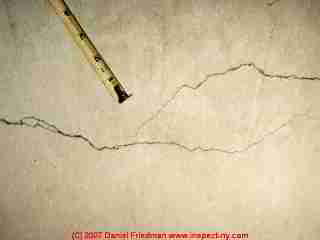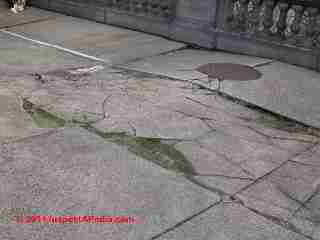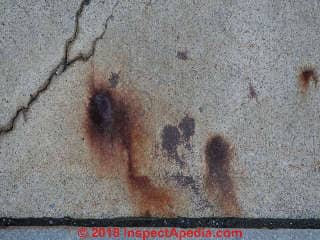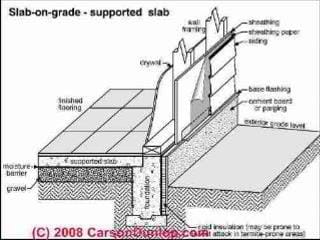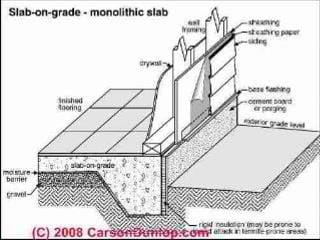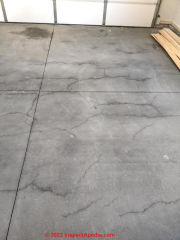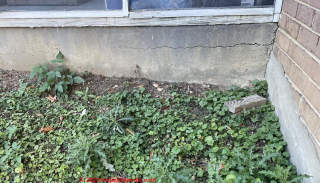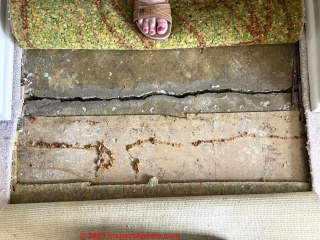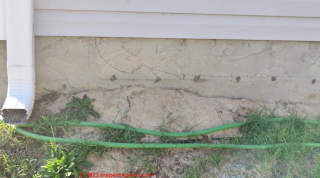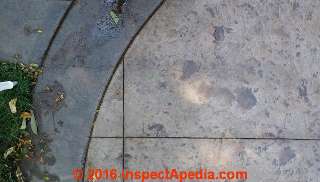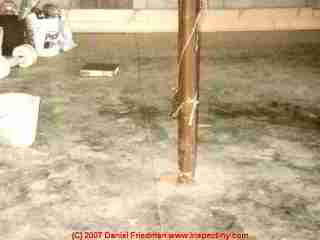 Evaluate Cracks in Poured Concrete
Evaluate Cracks in Poured Concrete
Concrete
Slab & Floor Cracking
- POST a QUESTION or COMMENT about cracked concrete slabs and floors
Floor slab & tile crack diagnosis & repair:
This article describes four common types of cracks that occur in poured concrete slabs or floors and explains the risks associated with each, thus assisting in deciding what types of repair may be needed.
Cracks in concrete floors or slabs occur in poured concrete slabs may be found both in basement and in slab on grade or "patio home" construction and have a variety of causes and cures that we discuss here as we explain how to repair cracked concrete floors and as we describe slab on grade construction or "patio home" construction cracks and as we review the diagnosis of cracks in ceramic tile over concrete slab floors,
This article series describes how to recognize and diagnose various types of foundation failure or damage, such as foundation cracks, masonry foundation crack patterns, and moving, leaning, bulging, or bowing building foundation walls.
InspectAPedia tolerates no conflicts of interest. We have no relationship with advertisers, products, or services discussed at this website.
- Daniel Friedman, Publisher/Editor/Author - See WHO ARE WE?
Four Types of Cracks in Concrete Slabs & Floors
Types of foundation cracks, crack patterns, differences in the meaning of cracks in different foundation materials, site conditions, building history, and other evidence of building movement and damage are described to assist in recognizing foundation defects and to help the inspector separate cosmetic or low-risk conditions from those likely to be important and potentially costly to repair.
- Shrinkage cracks in a slab [photo above]
are unlikely to be of any structural concern but can be a source of water entry or radon entry in buildings and may form a tripping hazard.
See details at CONCRETE SHRINKAGE CRACKS
- Settlement cracks in a slab [photo above]
indicate inadequate site preparation, such as failure to compact fill on which a slab was poured.
See details at SETTLEMENT CRACKS in SLABS
- Frost heaves or expansive soil damage [photo above]
can cause substantial damage to basement, crawl space, or garage floor slabs in some conditions.
See details at FROST HEAVES, FOUNDATION, SLAB
- Concrete cracks due to inclusions [photo above]
of shale and Iron sulfide mineral (pyrrhotite) cracking
See details at PYRRHOTITE INCLUSION CRACKING
Each type of concrete foundation, wall, basement slab, floor slab, or slab on grade crack is discussed and described with photographs below.
Other types of concrete cracking such as due to impact or loading are discussed in other articles at this website.
Cracks come to the job along with the concrete, riding in the same truck! At a Journal of Light Construction conference (Boston 1985) a lecturer informed us that "Every concrete truck that comes to your job to pour a slab has at least four cracks in it.
It's up to you to either provide control joints, or not. If you leave out control joints the cracks will occur in a messier pattern at natural stress points in the slab."
Types of Poured Concrete Slab Floors - Different Implications of Cracks & Movement
 Before we describe crack, movement, and damage patterns and diagnosis in concrete slabs, we need to introduce three different types of poured concrete floor slabs.
Before we describe crack, movement, and damage patterns and diagnosis in concrete slabs, we need to introduce three different types of poured concrete floor slabs.
We use the three Carson Dunlop Associates Sketches shown here to comment on the occurrence, causes, and significance of cracks and movement in poured concrete slab construction.
We define types of foundations and their common vulnerabilities also
at FOUNDATION CONSTRUCTION TYPES.
[Click to enlarge any image]
Floating concrete slab characteristics:
In the sketch at above left, the floor slab (left side of the foundation wall) is simply "floating" sitting atop gravel and soil inside the foundation wall.
This is an idealized sketch.
The author's first construction job (construction at the Fleet antiaircraft missile training center, Dam Neck, VA) consisted of raking roughly level loose-fill dirt inside of building foundations.
Over several summers of this labor we never once saw anyone using a soil compactor and rarely did we see gravel poured inside of the foundation walls before the slab was poured.
The bad news about typical floating slab construction (where the soil is not compacted) is that anything that causes the soil to settle risks slab cracking and settlement. Flooding, leaks, or simply poor handling of roof and surface runoff can send water under a building where it causes loose soil to settle.
The good news about cracks in floating slab construction is that the damage is to the floor, not to the structure that is supporting the building.
Only if you see a floor slab crack that continues up in the foundation wall where the crack meets the wall would the structure be obviously involved.
More good news: if there is significant soil settlement under a floating slab, the slab is likely to break and follow the settling soil downwards; a sudden precipitous collapse of a floating slab is less likely than the next case we describe.
Supported poured concrete floor slab characteristics
As you can see from the Carson Dunlop Associates sketch above, the supported slab is a lot like the floating slab - it claims to have gravel and claims to have compacted soil below the slab.
But the edges of the floor slab rest on a lip built into the poured concrete footing which also supports the building walls.
The good news about a slab with this design is that a little soil settlement below the slab will not cause the floor to tip nor crack provided it has been adequately reinforced.
The bad news about a supported slab design is that if there were significant soil settlement below the slab and if it lacked proper reinforcement at the time of construction, it might collapse.
Where may this occur: if you inspect a garage built on what was originally a sloping hill, you can expect that the interior of the garage foundation was filled with lots of backfill soil. If your builder was the same fellow who hired the author (as we described above in our discussion of floating slabs), all of this fill was left uncompacted.
At the low end of the garage where the most fill was added, significant soil settlement can occur. If the slab was also not reinforced and if a lot of soil settlement occurs under this floor, it could collapse suddenly, say when your car is parked there.
Slab on Grade - Monolithic Concrete Slab Construction Characteristics
As you see in the Carson Dunlop Associates sketch above (used with permission), a monolithic slab is poured at the same time as the building footing that is going to support the building's walls.
If structural cracks appear in a monolithic slab they might trace to footing settlement which might be a structural concern, depending on the amount of settlement, its origin, and type of building construction.
Notice that the sketch shows insulation on the exterior of the slab - unless special methods are used, it can be difficult otherwise to insulate this floor from the surrounding soils, an important factor in cold climates and where heating costs are increasing rapidly.
Where exterior foundation insulation is carried up above grade and right under the building exterior siding, there may be a risk of wood destroying insect attack on the wood-framed wall.
The articles listed below explain how we recognize and diagnose signs of cracking, damage, movement in these different concrete slab construction methods.
- See CONCRETE SLAB CRACK REPAIR
- See SINKING BUILDINGS where we include case histories of both building settlement and slab cracking, heaving, settling: diagnosis and repair.
- See FOUNDATION CRACK DICTIONARY since that article series also assists in distinguishing among types of cracking in concrete foundations (vertical supporting walls and footings).
...
Reader Comments, Questions & Answers About The Article Above
Below you will find questions and answers previously posted on this page at its page bottom reader comment box.
Reader Q&A - also see RECOMMENDED ARTICLES & FAQs
On 2023-11-10 by InspectApedia Publisher - so many concrete cracks in garage floor may indicate poor concrete mix
@JL,
No there are so many cracks that I think this was a ... well, less than optimum ... mix of concrete.
On 2022-04-28 by JL
Are these normal shrinkage cracks on a eight month old garage floor? The number seems excessive and some appear to be getting more prominent with chips.
On 2021-10-28 by inspectapedia.com.moderator - could soil settling cause horizontal crack in slab
@Larry,
That horizontal crack, tapering to zero, could indeed be due to subsidence of the soil below the footing for your porch.
Often a porch footing is more shallow than the footings supporting the main building, and if the porch was built on fill it might indeed settle, particularly if water spills nearby.
Often an inside corner of foundations like yours form a water trap if roof gutters overflow or spill into the area. And that in turn can invite both settlement and, depending on climate, frost heave. More concrete crack diagnosis is give above on this page and in the list of Recommended Articles too.
If the foundation remains vertical -not buckling or leaning, you might try doing nothing more than
- keeping roof spillage out of the area
- adding fill to be sure that surface runoff drains away from the building and away from the porch foundation
On 2021-10-27 by Larry
Crack on a concrete slab for an outdoor sunroom from 1960s. My initial thought is that there is no support for the slab as soil erosion has occurred through the years and there needs to be more support.
On 2021-07-22 by inspectapedia.com.moderator - deep crack in a third floor condo floor is worth a prompt assessment
@Jaykaym,
That crack is worth a prompt assessment; I doubt that anyone can say from the photo alone just what has happened, but because of the potential for dangerous structural damage, and in light of the recent condominium collapse in Florida, no one should ignore your question, not for a minute.
You're welcome to print this page on concrete floor cracks along with our OPINION if that helps you communicate to your condo association.
Tell us the country and city of location;
In the article above you'll see that concrete shrinkage cracks around the perimeter of a floor slab are common; where these occur on the ground floor in slab-on-grade construction, and where the floor remains level, usually the damage issues pertain to the floor alone, not to the supporting structure.
But one an NOT assume the same is true for a crack like the one in your photo as you report its on an upper floor in a multi-story building.
Further inspection to diagnose the cause of the crack and its effect on the structure is appropriate, and to be safe, urgent.
Do keep us informed as what you learn may help other readers.
On 2021-07-22 by Jaykaym
Looking for help evalulating a wide and very deep crack in a third floor condo floor. This condo was built in 1951 and the exterior construction is brick and block. Interior walls are plaster with metal mesh.
When we started to pull up carpet to look at the floor in preparation for a new glue-down engineered wood floor we found this major crack across a doorway where two portions of the building meet.
It is very, very deep - up to 6 inches in some places, and about a 1/2 inch+ wide. It is perfectly level across the crack. We have no cracks in any of the plaster walls.
I've submitted this picture to my condo association but they are very slow to respond to anything so I wondered if I should call in my own inspector to determine if this is structural or cosmetic.
I don't know if it is an actually poured concrete floor or if it is gypcrete. Comments? Ideas?
On 2021-06-30 by inspectapedia.com.moderator
@Eden,
Do let us know what you're told, and post additional photos, including from the building interior, and we can offer more.
On 2021-06-30 by Eden
@danjoefriedman, thank you, I have gone ahead and reached out to an inspector.
On 2021-06-28 by danjoefriedman (mod)
@Eden,
I'm not sure what's happening at your house and have almost no information, but I think I see a hairline horizontal crack at what might be the top mortar joint in a concrete block wall.
An expert inspection of the building with tell you whether the foundation wall is moving, leaning, sagging, bowing, Etc.
If it's not then that's not likely to be considered significant damage.
On 2021-06-27 by Eden
I have a crack in the concrete slab foundation of a patio home outside. I live in SC where it is humid most of the year, soil is sandy. The house is 20 years old. It extends horizontally for about a third of the house then just tapers off. Is this a problem ?
On 2021-05-23 by (mod) - what to ask the builder about cracks in a new concrete floor-slab
@Randy,
Thank you for taking the time to reply with an update. That will help other readers.
On 2021-05-23 by Randy
Thank you for the advice. The construction company owner and an engineer came to the meeting as well. They are going to mitigate the potential future issues and extended my foundation structural warranty from 10 to 20 years. They put it all in writing and my insurance guy gave it a thumbs up. Thanks for pointing me in the right direction!
On 2021-05-16 by (mod) - cracks in newly-poured slab, new construction
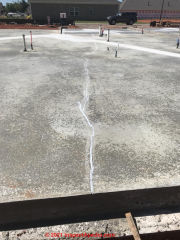 @Randy,
@Randy,
That looks like a large slab poured with no control joints; the manager may argue that they didn't need control joints because they used crack-proof concrete that includes an additive such as reinforcing fibres. In that case you'd simply point to the facts on the ground: looks cracked to me.
It also looks as if some sealant was put into the crack.
Every concrete pour is going to crack; the control joints are just that - something to control where and how the cracks appear and to minimize damage.
The climate, soil conditions, and soil prep may be relevant here; one would be a little concerned that there may be future
- water leaks up through the slab
- additional concrete movement
And what kind of reinforcement was used? Where and how was it placed?
Am I right there's no radiant heat tubing in this slab\?
And will someone test those pipes buried in the concrete to be sure they were not damaged? Better to discover that now while the fix is easier than later.
On 2021-05-16 by Randy
I discovered a crack in the foundation of our twin home we’re building. I am meeting with the construction mgr and I’m wondering what questions to ask and what answers to look for... thank you!
On 2021-05-12 - by (mod) -
@mrking,
In that case if you are in a freezing climate that cracking could be due to frost heave. If you're not in a freezing climate it could be due to water leaking underneath the slab in that location. In any case although it's a desirable fix it doesn't sound functionally urgent.
On 2021-05-12 by mrking
 thank you. i see no indication of cracks in the foundation ( it is a poured concrete foundation). the cracks and settling is contained to the garage floor entrance.
thank you. i see no indication of cracks in the foundation ( it is a poured concrete foundation). the cracks and settling is contained to the garage floor entrance.
On 2021-05-12 by (mod) - how to evaluate cracks & settlement in the garage cement floor
@mrking,
Please take a look at the suggestions in the article above on this page.
You'll see that we recommend making a distinction between cracks that involve only the garage floor and cracks that extended to the supporting foundations at walls.
The latter would require more extensive repair.
On 2021-05-11 by mrking
Hi. I bought a house last fall. It was built in 1977. The cement on the garage floor has several cracks and it sunk a bit by the entrance to the garage. The cracks have been patched and thus, far, I have not noticed any additional damage. I am wondering if it is necessary to repair/replace the floor or if I can just let it be.
On 2021-02-25 by (mod) - are these concrete floor cracks a concern?
 @Anthony Cantafio,
@Anthony Cantafio,
Some diagnostic questions and advice are given in more detail in the article above and in this article series, so please take a look and don't hesitate to ask if any of that is unclear.
From just your photo I don't know nearly enough to have a complete picture of the structure and the damage, its cause, history, impact on struture, need for repair, location, type of soil, age of structure, etc.
- is that occupied space or garage?
- how old, over what time did the cracks appear?
- is the foundation affected or only the slab
It *looks* like rather severe shrinkage cracking but as you'll read, additional details are important to understand what's going on.
What did your paid, on-site expert home inspector say?
On 2021-02-25 by Anthony Cantafio
I'm interested in buying a property with a structure on it. When inspecting I noticed these cracks in the concrete slab. Are they concerning?
On 2020-10-27 by (mod) - how to interpret cracks found in slab under carpet - caused by wiring?
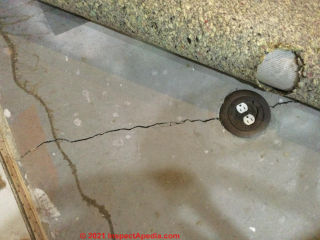 If you have the patience to read through the article above on this page you will see discussion of the things we consider in evaluating a crack in a concrete floor slab.
If you have the patience to read through the article above on this page you will see discussion of the things we consider in evaluating a crack in a concrete floor slab.
From just your photo I can't be certain of the overall condition in your house.
The location of cracks in a slab might follow wiring conduit placed in the slab but the underlying cause of the crack isn't likely to be due to the wiring.
Things like the age of the building and the probable age of the crack, whether or not the crack is only in the slab or whether it invades the perimeter Foundation, and whether or not there's a difference in height across the slab as well as the crack with all are examples of the factors that you would consider.
It's reasonable for you to make a preliminary assessment yourself and in the absence of any sign of substantial structural movement or involvement of the building foundation you might decide that you don't need to hire an experienced Mason or but expert for further evaluation
On 2020-10-26 by Tammy
We recently moved into an older home and found this crack under the carpet.
I am not sure if this is the result of the wiring or something I should’ve be worried about.
I suspect there is a similar crack near another floor socket in a room with wood flooring, based on a slight hill I feel around the plug. We live in Florida and have sandy soil. Is this something to worry about? The crack is 1/8” wide. Thanks so much for the information!
On 2020-08-25 - by (mod) -
how to avoid concrete slab or foundation damage in hot weather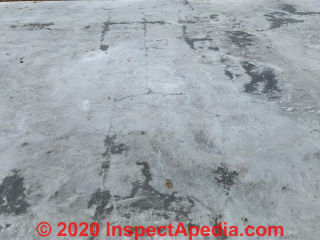 I see lots of shrinkage cracks; perhaps poor mix or poor temperature protection? What are those dark areas? Still wet, excessive water, over- or under- tooling?
I see lots of shrinkage cracks; perhaps poor mix or poor temperature protection? What are those dark areas? Still wet, excessive water, over- or under- tooling?
In any event, yes I'd be concerned about the strength of the slab if it was poured in very hot conditions (over 90F) if proper steps to protect the slab were not taken.
Expert sources we have reviewed pretty much agree that the best temperature range for placing concrete is between 40 F and 60F.
Pouring concrete when conditions are too hot (above 77 degF) (your case) means that some of the water hydrating the concrete evaporates rather than joining in the chemical reaction, increasing the chances of shrinkage cracks as well as making for a weak slab.
The PCA notes that
When the temperature of freshly mixed concrete approaches approximately 77 degrees Fahrenheit adverse site conditions can impact the quality of concrete. Ambient temperatures above 90 degrees Fahrenheit and the lack of a protected environment for concrete placement and finishing (enclosed building) can contribute to difficulty in producing quality concrete. - Hot Weather Concreteing Guide - https://www.cement.org/learn/concrete-technology/concrete-construction/hot-weather-concreting PCA, cited below
Often the concrete contractor pouring in very hot conditions will keep the concrete properly hydrated and she may also construct sunshades to protect the slab or foundation during initial curing. Concrete may also need to be protected from strong winds by erection of a wind-break. Other steps to protect concrete during placement in hot weather are given by PCA at the link I cited.
You can confirm these concrete pouring guidelines by contacting this industry source, though there's more discussion about the problems of pouring concrete in cold or freezing conditions than in too-hot conditions.
Portland Cement Association (PCA)
5420 Old Orchard Road
Skokie, Illinois 60077-1083
847.966.6200
Website: www.cement.org
Pouring concrete if the weather is too cold: poor chemical reaction in the formation of the concrete will mean weak concrete. Freezing, not a problem in your Texas concrete pour, also causes weak concrete.
On 2020-08-23 by EricDoty
New 32x36 slab poured in Texas heat, [Photo above] concrete poured at 0900 and work finished and forms removed by 1430. Slab is 4" with #3 rebar 12" on center, exterior beams are 12'x24' with 4 #5 rebar and stirrups 2' on center. This is what the slab looks like after 7 days. Is this cosmetic only, or should i be concerned about structural integrity?
On 2020-07-18 - by (mod) -
Jake I see the crack, possibly settlement, but can't see enough to understand the situation,
What are we looking at? top of a foundation wall, footing, edge of a slab, or what. Post another photo from more distance so I can see the context
On 2020-07-18 by Jake
Another picture of my sisters house foundation crack.
On 2020-07-18 by Jake
Hi,
My sister is having her first house built and went to see the foundation today. She noticed a few cracks - one that stood out most. Should she be concerned about this and raise this issue to the builder?
On 2020-07-13 - by (mod) -
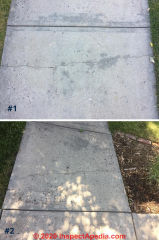 Lisa
Lisa
If there is a water leak under that sidewalk and the walk is cracked in two disparate locations, expansive clay soil could indeed be a factor.
Can you relate the crack to a change in height of the walk: risen, sunken? And can you relate the crack locations to a single point or source of water leak?
On 2020-07-13 by Lisa
Overnight (literally), two cracks appeared in our sidewalk concrete on two different slabs. They span the entire width of the slab.
The concrete adjacent to the cracks remained a little bit wet (see photo) late into the day even though it was a sunny scorcher today. This is leading me to think this is water issue (leak?), either with the lawn irrigation or city water supply (or sewer?). I don’t know exactly where the lines run. I’m putting a call into the city utilities department to stop by and check into it and our irrigation guy will be stopping by as well.
The concrete is not new, we moved in 9 years ago and the sidewalks were there at that time.
The only thing that’s different is that two days ago, we increased our irrigation schedule by double since our grass was struggling in the hot weather – could that really be the cause? Normally each zone gets 10 minutes of water in the early morning, we added a second round of 10 minutes to that – so the cycle runs (one zone at a time), the water absorbs, and then run again.
We live in Colorado and clay soil is very common here – I know that can be a factor with moisture and swelling.
Thanks for your help!
On 2020-06-27 - by (mod) -
Found
Sorry but I can't evaluate your concrete slab crack damage from just e-text. Photos of the site, slab pour, etc. might permit some more-helpful comment. (One photo per comment).
Some slab cracking such as shrinkage cracks at the perimeter or even in the field of the slab are common, not harmful unless they form a leak source, (and *might* have been avoided by use of control joints)
Other cracks could be a very early warning of future trouble, such as a settlement crack due to pouring on poorly-compacted fill. That may be obvious by the crack pattern and by a difference in elevation between the slab on the two sides of the crack.
Review the types of floor slab cracks in the article above and you'll have a better idea of the range of damage and the distinction between cosmetic and more serious cracks in concrete.
On 2020-06-27 by Foundation Crack Question
We are building our first home and they have started the framing. However, recently I noticed a hairline cracked from the back of the house to front door. We are building on a slab and block and fill. Is this normal? Does the pose serious structural issues down the road?
On 2019-07-24 - by (mod) -
Kris
It sounds as if the original piers were not adequately installed and that there was some ongoing settlement; but no one can really know that for sure from just e-text. It would make sense to have an onsite inspection by an engineer who is expert in residential construction and pier construction,
If / when the pier repairs are complete and properly done then the home should be stable. But we need to know more about the site, soil properties, pier design, etc. That's the job of the engineer and installer.
On 2019-07-24 by Kris
Our house was built on farm land that had all its sandy loam soil harvested. We are located in Texas northwest of Dallas. We have been here 18 years and the house is about 20years old. Three years ago we had piers installed on the west and north side of house
. Eight piers on a 2300 sq ft home single story. Since than we have noticed additional, gaping outside trim joints, and area of cracking on mortar joints of brick.
Foundation company found need to do 10 more piers, but husband requested for them to add three more piers to complete the circumference of house. Husbands concerns are that even with foundation repairs that the interior slab of house will start cracking ( he does have a construction background, working for a city doing house inspections of low income owners for a Hud program}.
He is wanting to sell house and move.There has been no severe cracking of interior walls or ceiling of home . How likely is something like this?
On 2019-04-22 - by (mod) -
Susan
Thank you for an interesting and important question but regrettably it's not something that one can diagnose and advised by text message. You need an expert onsite to evaluate the condition of your home. The retrofit that you're referring to is probably earthquake damage resistance. Looking for even considering that we need to know whether there's a repair needed.
On 2019-04-21 by Susan
We have discovered two large/long cracks in our concrete slab and at least one of them runs out to outside wall involving the foundation. We live in California, and I’ve heard that there are retrofit laws that have been put into effect that could cause real problems for us.
I’ve been trying to research such laws and haven’t been able to find the exact wording on said laws. We also have a large crack in the concrete slab the that is in an add on work ship. That was built in 1985 and the rest of the house was built in 1974. We are close to the epicenter of the 1992 Landers earthquake, in Big Bear Laue, CA. Could you please advise. Thanks.
On 2019-04-13 - by (mod) -
Jana
I don't assume that a wood floor gap is due to slab cracking unless there is other supporting data; after all the slab is covered -we can't see below the wood; before assuming it's the slab I'd wonder if there is or was movement in the floor itself.
You could do some moisture measurements (use an electronic device not a pin type) - if you see moisture higher at the crack that's indeed suspicious and raises the level of your water entry concern. At that point one might need to make a test opening to look into the floor cavity.
An astute inspector will find other probable causes of water entry outside or perhaps even inside.
On 2019-04-12 by Jana
We are thinking of purchasing a home that has a 1/4 inch space in the hardwood flooring that I can assume is from a cracked slab. We have seen this particular model of home with the same crack in it before. It doesn't appear to be on the outside wall of the home. It is as you walk inside in the first room on the interior.
My gut tells me this is a bad idea to purchase this home with this known problem. I am wondering though if we could fix it. My main concern would be water intrusion and mold buildup in the home as well as the integrity of the foundation. The house is 4 years old.
Reader Question: How do I diagnose and repair cracks in ceramic tile covered slab in a nearly-new home
We bought a house two years ago, after it sat empty as a model home for a few years, so now it’s about five years old. I believe it is a slab on grade foundation type--common in this area.
We live in Austin, Texas and the drought has been really bad here, and recently we have discovered a few hairline cracks in a few different tiles. These tiles are on the first story and so are on top of the concrete. One crack is about 4 feet long and runs straight through about 4 different tiles, not following the grout lines. (Theses cracks are hairline, and are barely noticeable.)
There is a lot of limestone and rock in the area, and so we never thought we’d ever have a problem here, unlike Houston, where foundation problems are everywhere. I kinda freaked out and started putting a level to everything in the house, and all the door frames are perfectly level and the countertops are very, very close to being perfectly level.
There a few small hairline cracks throughout the house in the sheetrock, but these were there when we moved in and haven’t gotten worse, and seemed pretty normal to me.
There is even a third story, which I know you’d see the most movement, (if there was sinking involved) but everything looks good up there(maybe a very slight slope to one side, like a ¼ inch over 10 feet)
Well, mentioning the drought, a few neighbors have said they have a few cracks too, and they had a foundation company come out, and the company told them it was because of the drought, and told them to soak the foundation.
I went out and bought soak hoses and are going to set that up, and I also bought a nice laser level and checked the slope of the foundation.
The foundation slopes about 1 inch over about 20 feet towards the left side of the house, which happens to be the downhill side. But with almost everything else level in the house, I’m starting to think it was already like that, and I just never noticed it before.
So this leads to my main question—how much slope in a foundation is generally acceptable to build on? Because I know brand new foundations won’t be perfectly level, but about how much can a new foundation be off-1 inch, 2 inches, 6 inches?
Thanks, C.M.
Reply: diagnose the crack type, impact on foundation, probable cause, and choose extent of repairs
Thanks for the interesting tile and slab crack question.
A competent onsite inspection by an expert usually finds additional clues that help accurately diagnose a foundation, slab, or floor cracking problem because someone with experience might see clues that escape even a smart, careful, thorough homeowner performing a DIY investigation. That said, here are some things to consider:
Decide if the floor and concrete cracks are structural or not
I agree that the cracks you describe are more likely due to slab settlement or movement and that considering Austin has been in a drought, soil settlement (rather than rising due to suddenly newly-wet expansive clay soils) is probably at work.
I also agree that other crack sources such as concrete slab shrinkage are probably not at fault. I think that slab shrinkage cracks appear early in building life, are not structural, and are less likely to suddenly telegraph through a ceramic tile floor.
(To be accurate, severe shrinkage cracks in a slab could show up in a tiled floor if the floor were not properly installed to prevent those cracks from telegraphing through the tile, but that just doesn't sound like your case.)
It's useful to distinguish between a crack that only affects the floor slab (usually not structural, the building is not threatened) and a crack that includes the foundations and footings (structural, the building might be threatened depending on extent of movement).
Evaluate the extent of actual foundation movement vs. slab cracking
While building codes expect footings to be poured level, I'm not surprised to read that a foundation and footing slope one inch over 20 feet in new construction. A key diagnostic step will be to convince yourself that this out of slope condition is as-built or that it is the result of settlement.
Examine the sloping foundation walls wherever masonry foundation materials and surfaces are visible. A one-inch change in slope, if it happened after construction, would often be expected to produce vertical or stair-stepped cracks in the foundation wall.
(While it's theoretically possible for an entire foundation or even building to settle or tip without cracking (I've found a few), you should not find upstairs floors, windows, doors, all dead level if the building had shifted one inch.)
Also take a look at the location and pattern of floor cracks,
If a crack line is more or less straight, and if it runs towards the foundation walls or more or less at right angle to the foundation wall, then if the foundation wall and footing had settled you'd expect to see wall cracks in the same area.
Evaluate the extent of floor slab settlement cracks
If those clues of actual footing settlement and foundation movement are absent, you are more likely seeing settlement in the concrete slab itself. Often floor slabs are not poured on compacted fill (they should be). The result can be future slab settlement and cracking, exacerbated by changes in site conditions (more water, less water, freezing, drying) that may affect the soil below the slab.
If the floor slab is poured with its perimeter sitting atop foundation footings (and presuming the footings are intact) the slab "hangs" on the footings, and perhaps also is "supported" by piers that may have been poured under the floor slab to support Lally columns that march down the center of a basement to support a main girder.
In that construction settlement of the slab may produce cracks as the floor bends and dirt below it settles. Cracks tend to be away from and sometimes roughly parallel to the foundation walls, or to appear as islands around the Lally columns.
If the floor slab was poured atop of dirt that covered the footings, or inside of the footings, the entire slab may settle or tip even at its perimeters.
In any case, the combination of pouring a slab on soft fill and changes in soil moisture invite soil settlement and slab cracking.
In fact my first job in construction was raking a huge dirt pile out to "level" inside of an already poured and built footing and masonry block foundation wall.
Once the dirt was roughly "level" via my hand rake, the builder went ahead and poured his floor slab. "Compacted fill" was not in our vocabulary.
See SETTLEMENT CRACKS in SLABS for details about cracking floor slabs due to settlement.
See SETTLEMENT IN FOUNDATIONS for a more broad explanation of foundation settlement diagnosis, evaluation, and repair.
Repairing Slab Cracks and Cracked Floor Tiles
We discuss several slab crack repair alternatives
at CONCRETE SLAB CRACK REPAIR.
Unfortunately there is no magic band-aid that will make the cracks disappear, especially where ceramic floor tiles are installed. If radon and water entry are not an issue in your area you might live with the cosmetic defect for a while.
Repair of the cracked floor will require removal of the cracked ceramic floor tiles, including enough mastic and crud removal that you can bed replacement tiles smoothly in place.
Before replacing the tiles that were removed you might want to also install mesh tape over the floor slab cracks to reduce the chances that those cracks telegraph again through the new tiles.
Also see INSTALLING TILE OVER CONCRETE SLAB FLOORS
Watch out: do not lay ceramic tiles across control joints as movement there is likely to cause cracking in the filed finish-floor .
Question: settlement at concrete steps & cracking in stamped concrete patio
[Click to enlarge any image]
2016/09/06 Anonymous said:
I had a stamped patio installed about four months ago. Recently I noticed that the steps appear to have settled some.
They used to be tight against the house, but there is now about a 3/16" gap. I am wondering if this is anything to be concerned about. I have also noticed some hairline cracks in various places on the patio less then 1/32" wide.
Also, any specific recommendations on how best to seal the gap against the house and the cracks? Thanks for any help.
[See the picture for which I've sent you a link. ]
- C.L.
Reply: Settlement for new steps or patios is most-often due to inadequate site preparation
Anon:
Settlement for new steps or patios is most-often due to inadequate site preparation such as building on poorly-compacted soil, though also roof spillage or surface runoff also cause settlement trouble.
I have posted your photos of both the concrete step settlement and the cracking in the stamped concrete patio along with your question here so that other readers can comment.
It looks as if the steps are settling to the right (in the photo) away from the building wall, perhaps from footing settlement, inadequate footings below the steps, or construction, as I speculated, on poorly compacted fill.
Unfortunately we cannot predict how much more settlement is going to occur without knowing more about the construction procedure and site preparation. For the amount of movement shown in your concrete stair photo, expensive repairs are not yet justified but they might become necessary if settlement continues.
If settlement continues you may be able to use a slab-jacking or helical pier repair as an alternative to reconstruction.
I would use a flexible concrete-colored sealant to keep water out of the joint between concrete steps and the wood-sided house wall. This is particularly important when a builder simply pours concrete on the ground and against a wood-framed, wood-sided structure as that design invites rot and termite or carpenter ant attack. Keeping the area dry reduces that risk.
As long as the crack in the stamped concrete patio is just hairline in width I would not try to seal that crack as the repair will be ugly and probably won't address the underlying cause anyway.
See SETTLEMENT CRACKS in SLABS.
More about stamped concrete is
Question: Causes of cracking in new fiber-reinforced concrete garage floor
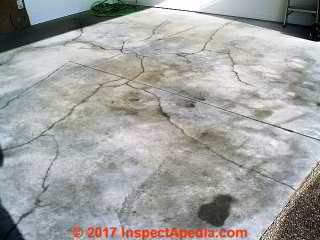 This question and a detailed reply have moved to a separate article now found
This question and a detailed reply have moved to a separate article now found
at CONCRETE REINFORCEMENT, FIBER.
I have a disagreement with our construction company’s warranty department over the cracks in our garage’s fiber-reinforced floating slab.
8. Several cracks run across length of slab; meandering.
9. Some stop and start again a ½ inch over then continues on same direction
10. Some cracks go right through the control point as if it wasn’t there
11. Control points are not v-shaped. One inch deep channel. Quarter inch wide.
12. No shrinkage separation space between slab and foundation
13. No water intrusion ...
Question:
(Apr 21, 2016) Danielle said:
My slab foundation has a crack in an outside corner of the house. It's path is from one wall to the other wall, about 11 inches long.
I discovered this crack when the carpet was removed. I see no water damage, but there is a huge shrub that was planted way too close to the foundation which means the roots may have caused this problem? I have not seen any bugs either.
Radon gas is probably not a problem since this house is a sieve (not really great construction). Can I leave this crack alone and carpet over it or should it be inspected?
Reply:
Danielle I would not carpet over an open crack; I'd seal it first.
Question: what does "BLK" mean when marked on concrete flooring by a crack?
(June 29, 2016) Carol said:
New home construction - pulled up cracked tiles - large crack in concrete flooring with inspector markings of "blk" in two areas around crack. What does "blk" stand for?
Reply:
Carol,
"blk" is not a standard building inspection abbreviation that I've seen. Sorry I don't know. Perhaps you could ask your local building inspector and let me know what she or he says.
Don't just put down more tile without a better evaluation of the cause of the cracking and its impact.
...
Continue reading at CONTROL JOINT CRACKS in CONCRETE or select a topic from the closely-related articles below, or see the complete ARTICLE INDEX.
Or see CONCRETE SLAB CRACK FAQs - questions and answers posted originally on this page.
Or see these
Recommended Articles
- CONCRETE COLD POUR JOINTS
- CONCRETE FOUNDATION, WALL, SLAB DEFECTS
- CONCRETE REINFORCEMENT, FIBER
- CONCRETE SHRINKAGE CRACKS
- CONCRETE SHRINKAGE CRACK REPAIR
- CONCRETE SLAB CRACK EVALUATION
- CONTROL JOINT CRACKS in CONCRETE
- FREEZING & WATER DAMAGED SLABS
- FROST HEAVE / EXPANSIVE SOIL CRACKS in SLABS
- SETTLEMENT CRACKS in SLABS
- SETTLEMENT vs. FROST HEAVE CRACKS
- SETTLEMENT vs. SHRINKAGE CRACKS
- SHRINKAGE CRACKS in SLABS
- SHRINKAGE CRACKS at FOUNDATION WALLS
- TEMPERATURE EFFECT on CONCRETE POUR
- CONCRETE SLAB CRACK REPAIR
- SOIL PROPERTIES & BUILDING FAILURES
Suggested citation for this web page
CONCRETE SLAB CRACK EVALUATION at InspectApedia.com - online encyclopedia of building & environmental inspection, testing, diagnosis, repair, & problem prevention advice.
Or see this
INDEX to RELATED ARTICLES: ARTICLE INDEX to BUILDING STRUCTURES
Or use the SEARCH BOX found below to Ask a Question or Search InspectApedia
Ask a Question or Search InspectApedia
Try the search box just below, or if you prefer, post a question or comment in the Comments box below and we will respond promptly.
Search the InspectApedia website
Note: appearance of your Comment below may be delayed: if your comment contains an image, photograph, web link, or text that looks to the software as if it might be a web link, your posting will appear after it has been approved by a moderator. Apologies for the delay.
Only one image can be added per comment but you can post as many comments, and therefore images, as you like.
You will not receive a notification when a response to your question has been posted.
Please bookmark this page to make it easy for you to check back for our response.
IF above you see "Comment Form is loading comments..." then COMMENT BOX - countable.ca / bawkbox.com IS NOT WORKING.
In any case you are welcome to send an email directly to us at InspectApedia.com at editor@inspectApedia.com
We'll reply to you directly. Please help us help you by noting, in your email, the URL of the InspectApedia page where you wanted to comment.
Citations & References
In addition to any citations in the article above, a full list is available on request.
- Branz Corporation, "Concrete Slabs and Conrol Joints", Build, Aug/Sept 2005, Branz, Moonshine Road, Judgeford, Porirua City 5381, New Zealand Post: Private Bag 50 908, Porirua 5240, New Zealand Phone: +64 4 237 1170 Fax: +64 4 237 1171 Email: branz@branz.co.nz Publication sales: publicationsales@branz.co.nz , Tel: Professionals helpline - 0800 80 80 85 - is available free to those who work within the New Zealand building and construction industry. Tel: consumer helpline is 0900 5 90 90. Calls cost $1.99 per minute, plus GST. Quoting: BRANZ is an independent and impartial research, testing, consulting and information company providing resources for the building industry.
- Masonry structures: The Masonry House, Home Inspection of a Masonry Building & Systems, Stephen Showalter (director, actor), DVD, Quoting:
Movie Guide Experienced home inspectors and new home inspectors alike are sure to learn invaluable tips in this release designed to take viewers step-by-step through the home inspection process. In addition to being the former president of the National Association of Home Inspectors (NAHI), a longstanding member of the NAHI, the American Society of Home Inspectors (ASHI), and the Environmental Standard Organization (IESO), host Stephen Showalter has performed over 8000 building inspections - including environmental assessments. Now, the founder of a national home inspection school and inspection training curriculum shares his extensive experience in the inspection industry with everyday viewers looking to learn more about the process of evaluating homes. Topics covered in this release include: evaluation of masonry walls; detection of spalling from rebar failure; inspection of air conditioning systems; grounds and landscaping; electric systems and panel; plumbing supply and distribution; plumbing fixtures; electric furnaces; appliances; evaluation of electric water heaters; and safety techniques. Jason Buchanan --Jason Buchanan, All Movie Review - Mark Cramer Inspection Services Mark Cramer, Tampa Florida, Mr. Cramer is a past president of ASHI, the American Society of Home Inspectors and is a Florida home inspector and home inspection educator. Mr. Cramer serves on the ASHI Home Inspection Standards. Contact Mark Cramer at: 727-595-4211 mark@BestTampaInspector.com
- John Cranor [Website: /www.house-whisperer.com ] is an ASHI member and a home inspector (The House Whisperer) is located in Glen Allen, VA 23060. He is also a contributor to InspectApedia.com in several technical areas such as plumbing and appliances (dryer vents). Contact Mr. Cranor at 804-873-8534 or by Email: johncranor@verizon.net
- Quality Standards for the Professional Remodeling Industry, National Association of Home Builders Remodelers Council, NAHB Research Foundation, 1987.
- Quality Standards for the Professional Remodeler, N.U. Ahmed, # Home Builder Pr (February 1991), ISBN-10: 0867183594, ISBN-13: 978-0867183597
- "Concrete Slab Finishes and the Use of the F-number System", Matthew Stuart, P.E., S.E., F.ASCE, online course at www.pdhonline.org/courses/s130/s130.htm
- Sal Alfano - Editor, Journal of Light Construction*
- Thanks to Alan Carson, Carson Dunlop, Associates, Toronto, for technical critique and some of the foundation inspection photographs cited in these articles
- Thanks to reader Michael Witten for technical editing, October 2010
- Terry Carson - ASHI
- Mark Cramer - ASHI
- JD Grewell, ASHI
- Duncan Hannay - ASHI, P.E. *
- Bob Klewitz, M.S.C.E., P.E. - ASHI
- Ken Kruger, P.E., AIA - ASHI
- Aaron Kuertz aaronk@appliedtechnologies.com, with Applied Technologies regarding polyurethane foam sealant as other foundation crack repair product - 05/30/2007
- Bob Peterson, Magnum Piering - 800-771-7437 - FL*
- Arlene Puentes, ASHI, October Home Inspections - (845) 216-7833 - Kingston NY
- Greg Robi, Magnum Piering - 800-822-7437 - National*
- Dave Rathbun, P.E. - Geotech Engineering - 904-622-2424 FL*
- Ed Seaquist, P.E., SIE Assoc. - 301-269-1450 - National
- Dave Wickersheimer, P.E. R.A. - IL, professor, school of structures division, UIUC - University of Illinois at Urbana-Champaign School of Architecture. Professor Wickersheimer specializes in structural failure investigation and repair for wood and masonry construction. * Mr. Wickersheimer's engineering consulting service can be contacted at HDC Wickersheimer Engineering Services. (3/2010)
- *These reviewers have not returned comment 6/95
- Best Practices Guide to Residential Construction, by Steven Bliss. John Wiley & Sons, 2006. ISBN-10: 0471648361, ISBN-13: 978-0471648369, Hardcover: 320 pages, available from Amazon.com and also Wiley.com. See our book review of this publication.
- Decks and Porches, the JLC Guide to, Best Practices for Outdoor Spaces, Steve Bliss (Editor), The Journal of Light Construction, Williston VT, 2010 ISBN 10: 1-928580-42-4, ISBN 13: 978-1-928580-42-3, available from Amazon.com
- Avongard FOUNDATION CRACK PROGRESS CHART [PDF] - structural crack monitoring
- Building Pathology, Deterioration, Diagnostics, and Intervention, Samuel Y. Harris, P.E., AIA, Esq., ISBN 0-471-33172-4, John Wiley & Sons, 2001 [General building science-DF] ISBN-10: 0471331724 ISBN-13: 978-0471331728
- Building Pathology: Principles and Practice, David Watt, Wiley-Blackwell; 2 edition (March 7, 2008) ISBN-10: 1405161035 ISBN-13: 978-1405161039
- Construction Drawings and Details, Rosemary Kilmer
- CRAWL SPACE MOISTURE CONTROL [PDF] U.S. Department of Energy
- Diagnosing & Repairing House Structure Problems, Edgar O. Seaquist, McGraw Hill, 1980 ISBN 0-07-056013-7 (obsolete, incomplete, missing most diagnosis steps, but very good reading; out of print but used copies are available at Amazon.com, and reprints are available from some inspection tool suppliers). Ed Seaquist was among the first speakers invited to a series of educational conferences organized by D Friedman for ASHI, the American Society of Home Inspectors, where the topic of inspecting the in-service condition of building structures was first addressed.
- Design of Wood Structures - ASD, Donald E. Breyer, Kenneth Fridley, Kelly Cobeen, David Pollock, McGraw Hill, 2003, ISBN-10: 0071379320, ISBN-13: 978-0071379328
This book is an update of a long-established text dating from at least 1988 (DJF); Quoting:
This book is gives a good grasp of seismic design for wood structures. Many of the examples especially near the end are good practice for the California PE Special Seismic Exam design questions. It gives a good grasp of how seismic forces move through a building and how to calculate those forces at various locations. THE CLASSIC TEXT ON WOOD DESIGN UPDATED TO INCLUDE THE LATEST CODES AND DATA. Reflects the most recent provisions of the 2003 International Building Code and 2001 National Design Specification for Wood Construction. Continuing the sterling standard set by earlier editions, this indispensable reference clearly explains the best wood design techniques for the safe handling of gravity and lateral loads. Carefully revised and updated to include the new 2003 International Building Code, ASCE 7-02 Minimum Design Loads for Buildings and Other Structures, the 2001 National Design Specification for Wood Construction, and the most recent Allowable Stress Design. - Building Failures, Diagnosis & Avoidance, 2d Ed., W.H. Ransom, E.& F. Spon, New York, 1987 ISBN 0-419-14270-3
- Domestic Building Surveys, Andrew R. Williams, Kindle book, Amazon.com
- Defects and Deterioration in Buildings: A Practical Guide to the Science and Technology of Material Failure, Barry Richardson, Spon Press; 2d Ed (2001), ISBN-10: 041925210X, ISBN-13: 978-0419252108.>
- Guide to Domestic Building Surveys, Jack Bower, Butterworth Architecture, London, 1988, ISBN 0-408-50000 X
- "Avoiding Foundation Failures," Robert Marshall, Journal of Light Construction, July, 1996 (Highly recommend this article-DF)
- "A Foundation for Unstable Soils," Harris Hyman, P.E., Journal of Light Construction, May 1995
- "Backfilling Basics," Buck Bartley, Journal of Light Construction, October 1994
- "Inspecting Block Foundations," Donald V. Cohen, P.E., ASHI Reporter, December 1998. This article in turn cites the Fine Homebuilding article noted below.
- Quality Standards for the Professional Remodeling Industry, National Association of Home Builders Remodelers Council, NAHB Research Foundation, 1987.
- Quality Standards for the Professional Remodeler, N.U. Ahmed, # Home Builder Pr (February 1991), ISBN-10: 0867183594, ISBN-13: 978-0867183597
- In addition to citations & references found in this article, see the research citations given at the end of the related articles found at our suggested
CONTINUE READING or RECOMMENDED ARTICLES.
- Carson, Dunlop & Associates Ltd., 120 Carlton Street Suite 407, Toronto ON M5A 4K2. Tel: (416) 964-9415 1-800-268-7070 Email: info@carsondunlop.com. Alan Carson is a past president of ASHI, the American Society of Home Inspectors.
Thanks to Alan Carson and Bob Dunlop, for permission for InspectAPedia to use text excerpts from The HOME REFERENCE BOOK - the Encyclopedia of Homes and to use illustrations from The ILLUSTRATED HOME .
Carson Dunlop Associates provides extensive home inspection education and report writing material. In gratitude we provide links to tsome Carson Dunlop Associates products and services.


